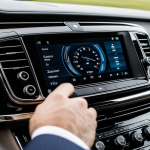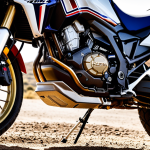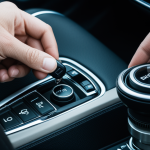Understanding Tire Air Pressure and Its Importance
Tire air pressure is crucial for optimal vehicle stability. Properly inflated tires maintain the grip and balance necessary for safe driving, especially during sharp turns or sudden maneuvers. Without the right tire pressure, you risk reduced tire performance and compromised vehicle stability, potentially leading to dangerous situations.
When tire air pressure is correct, the vehicle runs smoothly, ensuring even tire wear and optimal fuel efficiency, reflecting improved overall tire performance. Stability during drives, especially in inclement weather conditions, highlights the importance of adhering to recommended pressures. On the contrary, incorrect tire pressure can severely impact your driving experience. Underinflated tires can overheat, leading to possible blowouts, whereas overinflated tires might reduce grip and increase braking distances, endangering safety and handling.
Also to read : Mastering Drift Dynamics: Your Authoritative UK Guide to Safe and Legal Car Enhancements for Ultimate Drift Performance
Ensuring your tires are neither under nor overinflated is key to maintaining their integrity and longevity. Checking your tire’s pressure regularly can prevent these issues, promoting consistent and safe driving experiences. By understanding the vital role of tire air pressure, you safeguard yourself, your passengers, and your vehicle on every journey.
Recommended Tire Air Pressure for Piaggio MP3
The Piaggio MP3 is known for its innovative design, combining the agility of a scooter with the stability of a tricycle. Maintaining the recommended tire air pressure is essential for achieving this balance. Piaggio provides specific tire pressure specifications to ensure optimal performance and safety. For front tires, the recommended pressure generally ranges around 2.0 bars, while rear tires often require about 2.2 bars.
Also read : Essential Tips for Ensuring Your Vehicle Stays UK Road-Ready on Rural Commutes
Adjustments might be necessary depending on riding conditions. For instance, when carrying additional loads or during long-distance travel, slightly higher pressures might optimize handling and fuel efficiency. Conversely, lower pressures might be advisable on rough or slippery terrain to enhance grip.
Adhering to manufacturer guidelines is critical. Deviating from these recommendations can compromise tire performance and the vehicle’s unique stability. It’s not solely about maintaining the correct pressure, but also about recognizing how different conditions affect your Piaggio MP3’s tires. Maintaining proper tire pressure not only enhances safety but also prolongs the lifespan of your tires, supporting the overall functionality and performance of your vehicle. Regular checks and adjustments, paired with the manufacturer’s advice, are key to a safer, smoother ride.
Measuring and Adjusting Tire Air Pressure
Understanding how to effectively measure and adjust your vehicle’s tire air pressure is crucial for maintaining optimal tire performance and ensuring vehicle stability.
Tools Required
To accurately measure your tire pressure, you’ll need a tire pressure gauge. There are two main types: digital and analog. Digital gauges are praised for their precision and ease of reading. However, many find analog gauges durable and equally dependable, provided they are well-calibrated.
Step-by-Step Guide to Measuring
Begin by ensuring that your tires are cold, as heat can cause an inaccurate reading. Remove the valve cap, and firmly attach the gauge to the valve. Note the reading and compare it with the recommended pressure levels.
Adjusting Tire Pressure
Inflate tires by adding air until achieving the correct pressure; for deflation, release air gently using the valve core. Be mindful to avoid common mistakes such as not checking pressures often enough or ignoring load effects. Regular monitoring and adherence to guidelines reward you with enhanced safety and driving experience.
Maintaining Optimal Tire Air Pressure
Proper tire maintenance is vital for ensuring safety and prolonging your tire’s life. Routinely checking your tire pressure helps prevent safety hazards and enhances vehicle performance. Environmental factors, such as temperature and altitude, can significantly affect tire pressure. For instance, cold weather typically lowers air pressure, while heat can increase it. Both conditions necessitate regular monitoring to maintain pressure within safe limits.
Consistent tire care ensures uniform wear patterns, avoiding premature wear. Regular checks assist in spotting issues such as slow leaks, which can lead to underinflation. Correcting tire pressure ensures balanced weight distribution, crucial for maintaining vehicle stability.
Tips for maintaining consistent air pressure include using a reliable gauge and checking pressure at least once a month. Make a habit of inspecting tires in the morning when they are cold, ensuring more accurate readings. Adjust for loads and driving conditions by following manufacturer guidelines—doing so prevents handling issues and improves fuel efficiency. Ultimately, maintaining optimal tire air pressure helps safeguard your vehicle and its occupants, promoting a smoother driving experience.
Troubleshooting Common Tire Issues
Understanding tire issues and effective troubleshooting is essential for maintaining tire performance and safety.
Identifying Common Problems
Common tire issues often arise due to incorrect tire air pressure. Symptomatic indications include unusual vibrations, poor vehicle stability, or uneven tire wear. Low pressure typically results in decreased fuel efficiency and compromised handling, whereas high pressure can lead to overly stiff tires, affecting grip. Addressing these signs promptly is crucial to prevent deterioration in performance and ensure safety. Recognizing consistently low pressure could signify underlying leaks or tire damage requiring immediate attention.
Solutions for Common Tire Issues
Addressing tire issues begins with regular checks. Underinflation can be rectified by inflating tires to manufacturer-specified levels using reliable pressure gauges. For overinflation, cautious deflation is advised to prevent sudden pressure loss. Persistent issues may require professional inspection to avoid long-term consequences. Comprehensive troubleshooting techniques include examining for visible punctures or embedded objects, which can lead to leaks. Preventative upkeep like routine inspections and adherence to recommended pressure levels fosters longevity and reliability in tire performance.
Prioritizing regular maintenance and swift response to potential issues ensures not only the extended lifespan of tires but significantly enhances the overall safety of your driving experience.
Additional Resources and Tools
A comprehensive guide to maintaining tire performance and vehicle stability encompasses not only techniques but also the use of valuable resources and tools. Online platforms offer a wealth of tire pressure tools that provide practical assistance for both novice and experienced drivers.
For example, interactive tire pressure charts can be found on various automotive websites that allow you to input specific data, like your vehicle make and model, providing tailored pressure recommendations. These resources ensure you’re adhering to ideal standards, enhancing safety and prolonging tire life.
Online communities and forums, especially those dedicated to Piaggio MP3 owners, can offer firsthand experiences and tips about tire maintenance, helping you to troubleshoot common challenges effectively. Participating in these discussions promotes a deeper understanding of tire issues and fosters a supportive network for problem-solving.
Be sure to leverage infographics, which are effective at visually presenting complex topics, simplifying understanding and aiding memory retention about tire pressure management. Keep an eye out for well-designed infographics on transportation-related websites and blogs or consider creating custom visuals that align with your needs. These resources can greatly enhance routine checks and bolster the effectiveness of your overall maintenance strategy.
Visual Aids and Infographics
Exploring visual aids and infographics on tire pressure can significantly boost your understanding of this crucial topic. These tools offer a simplified, engaging way to convey complex information effectively. By distilling detailed data into a format that is quick to grasp, such aids ensure you retain crucial information about tire pressure management.
Visuals such as tire pressure charts allow you to easily reference and compare specifications, aiding in maintaining optimal tire health. These charts are particularly useful for quickly identifying the correct pressure for various vehicle types without sifting through verbose manuals.
When creating or finding infographics, seek those that visually demonstrate how deviations in tire pressure impact vehicle stability and performance. They can illustrate scenarios, detailing the repercussions of incorrect pressure on safety and handling.
Moreover, utilizing infographics provides a hands-on approach to learning, crucial for repeating routine tasks like pressure checks. By employing these resources, you equip yourself with knowledge that enhances practical application and ensures greater safety on the road, reinforcing overall tire performance and extending tire life.
Visual Aids and Infographics
Leveraging visual aids and infographics is instrumental in understanding tire pressure management in a more intuitive manner. Infographics simplify complex concepts, making tire pressure guidelines accessible and memorable. They break down information into visually engaging formats, which are easier to grasp than textual explanations alone.
Infographics such as tire pressure charts are invaluable for providing quick, clear references. They allow users to easily locate the correct pressure specifications for different vehicle models, ensuring accurate tire maintenance. Understanding how tire pressure affects vehicle stability and performance becomes straightforward with visuals that showcase potential outcomes of deviations in pressure.
When choosing or creating infographics, focus on those that effectively depict scenarios showing the importance of maintaining accurate tire pressure. Visual aids demonstrating how incorrect pressures can impact safety and handling are particularly beneficial. Additionally, hands-on infographics encourage proactive learning, aiding in routine tasks like self-checks on tire pressure.
Incorporating these resources into your tire maintenance routine not only enhances comprehension but also reinforces practical application, ensuring safer, more efficient driving. Visual tools empower users by transforming essential maintenance knowledge into a readily consumable and easily applied format.





